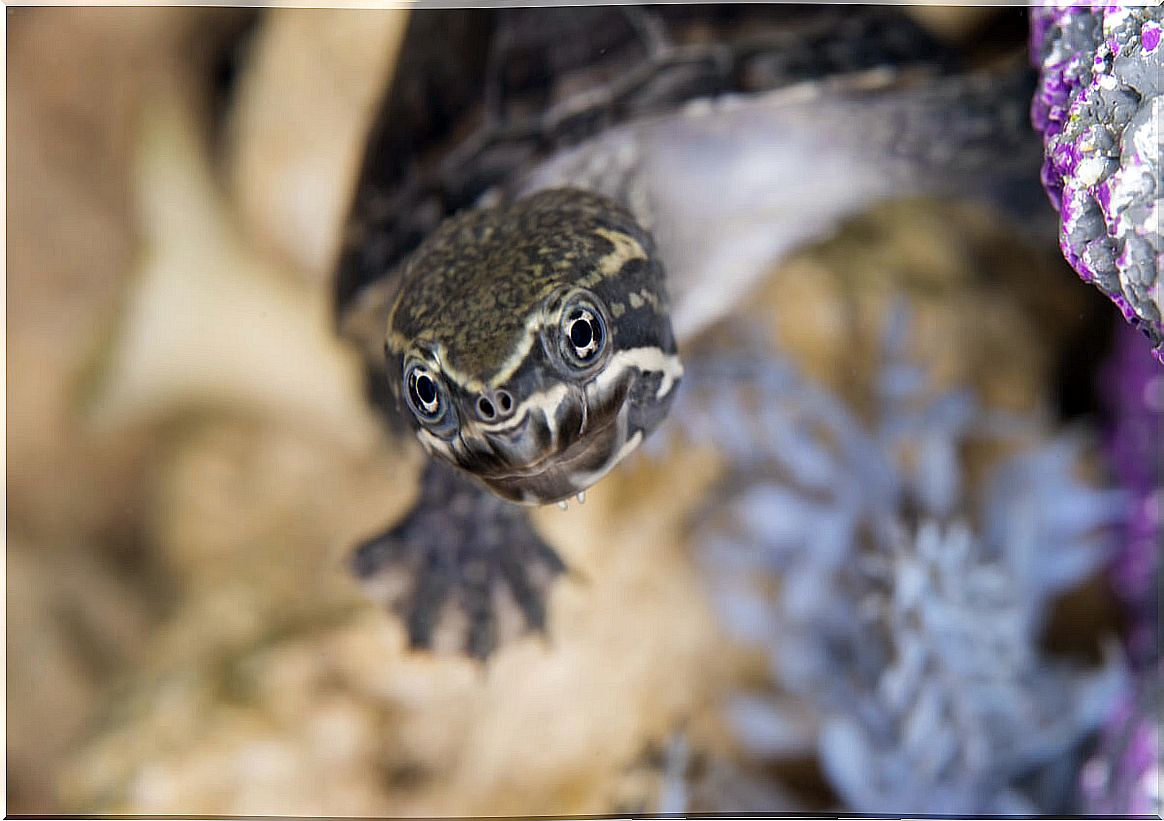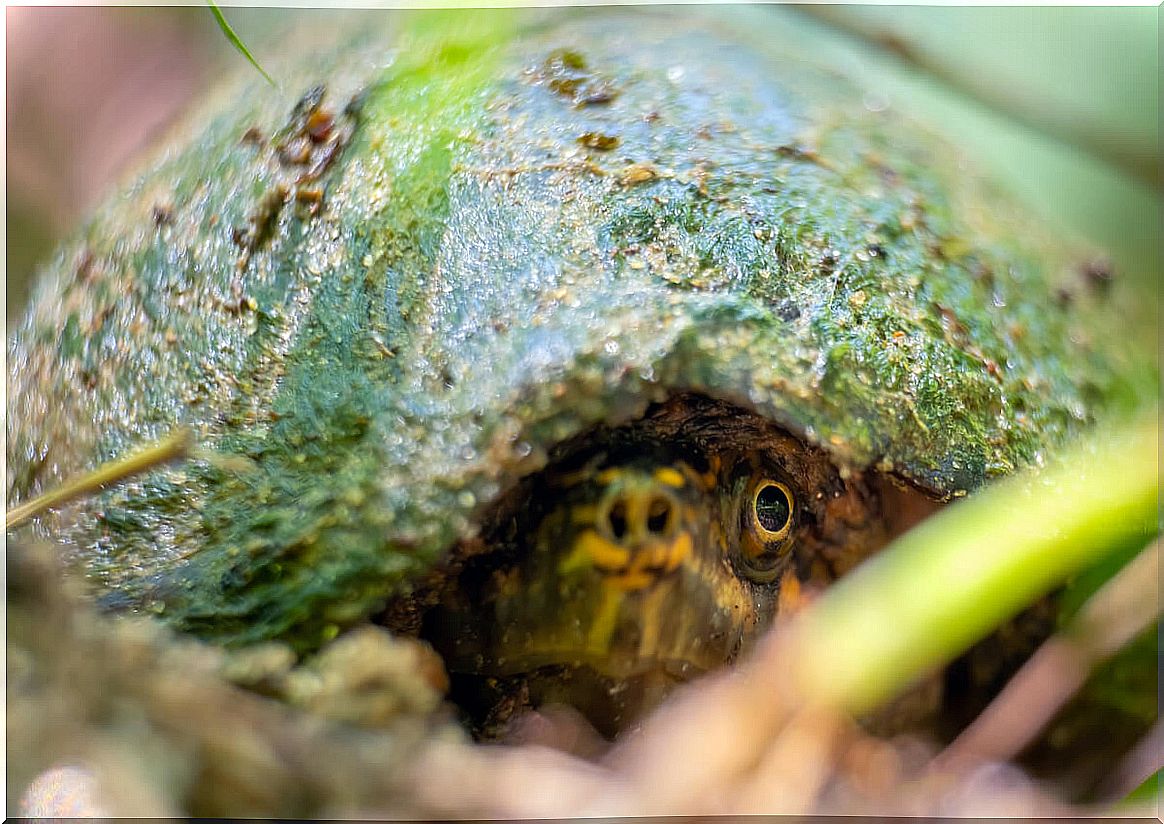The Musk Turtle And The Mystery Of Its Hibernation

The common musk turtle ( Sternotherus odoratus ) is an abundant species included in the taxon of chelonians, which inhabits any permanent body of water. It is easy to find in shallow stream waters, ponds, rivers, or clear-water lakes.
Despite its inconspicuous appearance and characteristics shared with other members of its group, this turtle hides a great secret: its ability to hibernate. If you want to know everything about this fascinating process, read on.
What traits characterize the musk turtle?
The most prominent behavior of the common musk turtle is its defensive tactic. When disturbed, this tortoise quickly releases a foul-smelling fluid from its musk glands, giving it its common name. In addition, this type of defense earned the musk turtle the nickname “stinky.”
The male of this species is particularly aggressive and will not think twice about biting. Another unique behavior that the common musk turtle exhibits is walking on the bottom of the stream or pond, rather than swimming like other turtles.

Geographical distribution
This species can be found along the eastern coast of the United States, from the northeastern states to Florida. Its range extends west to the Great Lakes region, through Illinois, to western Kansas and Oklahoma, and reaches its westernmost distribution in central Texas.
The hibernation challenge for the musk turtle
It should be noted that turtles are ectothermic animals – like other reptiles – that is, they are not capable of generating their own internal heat. For this reason, they depend on external heat sources to reach a certain body temperature.
If the water in the pond in which the animal lives is at a temperature of 1 ℃, its body temperature will be very similar. Therefore, if it happens that the climatic conditions are not suitable for the animal, it responds by restricting its metabolic activity.
Many freshwater turtles in temperate climates can spend winter periods submerged in water under ice or in mud where oxygenation is poor, posing a survival challenge. The case of the species that concerns us here is the most extreme of all.
In general, turtles cannot survive having ice crystals on their bodies. This is why they seek to hibernate in water, where their body temperatures remain relatively stable and will not freeze.
In addition to oxygen depletion, freezing and desiccation are the main challenges during hibernation. To get around these conditions, the musk turtle’s body must adapt for long periods of time.
What is the secret that allows the musk turtle to live underwater?
This doubt assails us, because we know that turtles have lungs and breathe air. So how does this animal survive in a frozen pond covered in ice? These turtles have achieved an adaptation of their metabolism in response to the temperature of the environment which, as we saw before, determines their body temperature.
The first thing that happens when this animal is exposed to cold water is that it slows down its metabolism. The colder the environment gets, the slower your metabolism, therefore, the demand for energy and oxygen decreases.
But do you still need oxygen?
Definitely and like all other complex living beings, these turtles need oxygen even in their hibernation state. It is interesting to know that, in this unique situation, the turtles absorb the oxygen dissolved in the pond water, according to studies.
The exchange occurs extrapulmonary, through a very thin skin body surface that flush the blood vessels. This curious event occurs in a structure called the cloacal bursa.
The technical term for the process is cloacal respiration and it is possible because the turtle’s cloaca is endowed with the muscles that allow water to enter and exit. This way, you can get enough oxygen to meet your minimal needs without using your lungs.
The musk turtle’s adaptation to temperature drops
Another crucial event, which derives from the decrease in metabolism, is dealing with the accumulation of lactic acid in the body. Such increased concentration of the compound can be dangerous and even lethal if it continues for a long time.
But how long is too long? Studies have shown that several species of water turtles can survive forced immersion in cold temperatures in the laboratory for more than 100 days.
It is surprising to learn that these turtles mobilize calcium from their shells to neutralize lactic acid. In this way, they effect a balancing process similar to that which occurs when we take antacids that contain calcium for heartburn.

It’s not a sweet awakening
In the spring, when the turtles emerge from hibernation, they wake up in pain and numbness. For this reason, they are desperate to sunbathe to increase their body temperature, speed up their metabolism, and eliminate these acidic by-products.
Upon awakening, the turtles are very vulnerable to predators and other dangers. In addition, during hibernation they gain weight due to the absorption of water, but apparently they maintain some kidney function.









